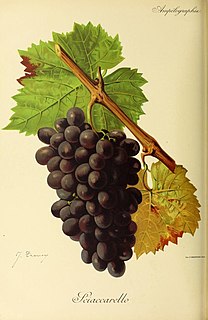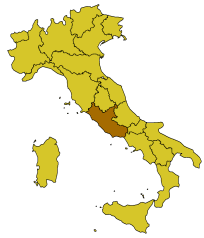Related Research Articles

Dolcetto is a black Italian wine grape variety widely grown in the Piedmont region of northwest Italy. The Italian word dolcetto means "little sweet one", but it is not certain that the name originally carried any reference to the grape’s sugar levels: it is possible that it derives from the name of the hills where the vine is cultivated. In any case the wines produced are nearly always dry. They can be tannic and fruity with moderate, or decidedly low, levels of acidity and are typically meant to be consumed within a few years after release.

Sangiovese is a red Italian wine grape variety that derives its name from the Latin sanguis Jovis, "the blood of Jupiter". Though it is the grape of most of central Italy from Romagna down to Lazio, Campania and Sicily, outside Italy it is most famous as the only component of Brunello di Montalcino and Rosso di Montalcino and the main component of the blends Chianti, Carmignano, Vino Nobile di Montepulciano and Morellino di Scansano, although it can also be used to make varietal wines such as Sangiovese di Romagna and the modern "Super Tuscan" wines like Tignanello.
Negroamaro is a red wine grape variety native to southern Italy. It is grown almost exclusively in Apulia and particularly in Salento, the peninsula which can be visualised as the "heel" of Italy. The grape can produce wines very deep in color. Wines made from Negroamaro tend to be very rustic in character, combining perfume with an earthy bitterness. The grape produces some of the best red wines of Apulia, particularly when blended with the highly scented Malvasia Nera, as in the case of Salice Salentino.

Canaiolo is a red Italian wine grape grown through Central Italy but is most noted in Tuscany. Other regions with plantings of Canaiolo include Lazio, Marche and Sardegna. In Umbria a white berried mutation known as Canaiolo bianco exists. Together with Sangiovese and Colorino it is often used to create Chianti wine and is an important but secondary component of Vino Nobile di Montepulciano. In the history of Chianti it has been a key component blend and during the 18th century may have been the primarily grape used in higher percentage than Sangiovese. Part of its popularity may have been the grape's ability to partially dry out without rotting for use in the governo method of prolonging fermentation. In the 19th century, the Chianti recipe of Bettino Ricasoli called for Canaiolo to play a supporting role to Sangiovese, adding fruitiness and softening tannins without detracting from the wine's aromas. In the aftermath of the phylloxera epidemic, the Canaiolo vines did not take well to grafting onto new American rootstock and the grape began to steadily fall out of favor. As of 2006, total plantings of Canaiolo throughout Italy dropped to under 7,410 acres. Today there are renewed efforts by Tuscan winemakers to find better clonal selections and re-introduce the variety into popular usage.

Sciacarello is a red Italian wine grape variety that is grown primarily in Corsica. It is most noted for the wines that come from Ajaccio which tend to be highly perfumed. It is also associated with wines from Calvi, and in the Sartène region around Propriano. The grape is normally blended and rarely made into a varietal wine. Sciacarello is believed to be a parent vine of the Ligurian-Tuscan wine grape, pollera nera. Di Vecchi Staraz, Bandinelli, Boselli, This, Boursiquot, Laucou, Lacombe, and Varès (2007) showed that Sciaccarello and another Corsican variety Malvasia Montanaccio as well as Tuscan varieties Biancone, Caloria, Colombana Nera, and Pollera Nera have genetic ties to Mammolo.

Marzemino is a red Italian wine grape variety that is primarily grown around Isera, south of Trentino. The wine is most noted for its mention in the opera Don Giovanni of Wolfgang Amadeus Mozart. The vine ripens late and is susceptible to many grape diseases including oidium. Wine produced from the grape has a characteristic dark tint and light plummy taste.

Cesanese Comune is a red Italian wine grape variety that is grown primarily in the Lazio region. The grape has three Denominazione di origine controllata (DOC) regions dedicated to it-Cesanese di Affile DOC, Cesanese di Olevano DOC and Cesanese di Piglio DOC. Cesanese di Affile appears to be a distinct sub-variety of Cesanese Comune unique to the commune of Affile. There are noticeable differences between Cesanese Comune and the grapes found in Cesanese di Affile, including the size of the grape berry itself. The sub-variety Cesanese d'Affile is considered to be of superior quality of Cesanese Comune and is used as minor ingredient in the Tuscan cult wine Trinoro. The grape has very old origins, and may have been used in Roman winemaking. Today it is rarely seen outside of the Lazio.

Gaglioppo is a red wine grape that is grown in southern Italy, primarily around Calabria. The vine performs well in drought conditions but is susceptible to oidium and peronospora. The grape produces wine that is full-bodied, high in alcohol and tannins with a need for considerable time in the bottle for it to soften in character. It is sometimes blended with up to 10% white wine.

Montepulciano is a red Italian wine grape variety that is most noted for being the primary grape behind the DOCG wines Offida Rosso, Montepulciano d'Abruzzo, Montepulciano d'Abruzzo Colline Teramane, Rosso Conero and the DOC wine Rosso Piceno Superiore.
Susumaniello is a variety of red wine grape from the 'heel' of Italy. It is an ancient grape variety which is grown in the province of Brindisi in the southern Italian region of Apulia.

Tuscan wine is Italian wine from the Tuscany region. Located in central Italy along the Tyrrhenian coast, Tuscany is home to some of the world's most notable wine regions. Chianti, Brunello di Montalcino and Vino Nobile di Montepulciano are primarily made with Sangiovese grape whereas the Vernaccia grape is the basis of the white Vernaccia di San Gimignano. Tuscany is also known for the dessert wine Vin Santo, made from a variety of the region's grapes. Tuscany has forty-one Denominazioni di origine controllata (DOC) and eleven Denominazioni di Origine Controllata e Garantita (DOCG). In the 1970s a new class of wines known in the trade as "Super Tuscans" emerged. These wines were made outside DOC/DOCG regulations but were considered of high quality and commanded high prices. Many of these wines became cult wines. In the reformation of the Italian classification system many of the original Super Tuscans now qualify as DOC or DOCG wines but some producers still prefer the declassified rankings or to use the Indicazione Geografica Tipica (IGT) classification of Toscana. Tuscany has six sub-categories of IGT wines today.
Drupeggio is a white Italian wine grape variety that is grown in the Central Italy wine regions of Tuscany and Orvieto. The grape is often confused for the white Tuscan variety Vernaccia di San Gimignano, which is also known under the synonym Canaiolo bianco and may be counted as one and the same in field blends.

Colorino is a red Italian wine grape variety planted primarily in Tuscany. The grape is known for its deep dark colouring and is used primarily as a colouring agent in red blends. In the history of Chianti it played a minor role, mostly for its affinity and use to the governo winemaking technique. Like Canaiolo, Colorino did not rot easily while going through the partial drying process to later be added to the fermenting grape must. However the grape did not provide the same level of fruit and softening effect that Canaiolo did and fell out of favour. In the late 1980s, there was a surge of interest in the variety among Tuscan winemakers who saw in this local grape variety similarity to the role Petit Verdot plays in Bordeaux blends. Colorino was planted and used to add darker colours and structure from phenolic compounds in the grape's thick skin without the overpowering aromatics that Cabernet Sauvignon could add. This enthusiasm was short lived and by the turn of the 21st century Colorino returned once again to a minor role in Tuscan wines.
Fortana is a red Italian wine grape variety grown primarily in the Emilia–Romagna region of northern Italy. A permitted grape variety in several Denominazione di origine controllatas (DOCs), mostly in Emilia, Fortana mostly contributes tartness and acidity in red blends.
Pollera nera is a red Italian wine grape variety that is grown primarily in the Liguria wine region and northwest Tuscany. Ampelographers believe that the vine has a very long winemaking history but it is rarely seen today. It is believed to have been descended from the Chianti wine grape Mammolo and the Corsican wine grape Sciacarello which would make it a half-sibling of Colombana nera.

Colli di Luni is an Italian Denominazione di origine controllata (DOC) located in both Liguria and Tuscany in northwest Italy. The DOC produces both reds and white wines made primarily from Sangiovese and Vermentino with a varietal Vermentino also being produced in the DOC.
Rossola nera is a red Italian wine grape variety that has been growing in the Valtellina region of Lombardy since at least the 17th century. In 2004 DNA profiling determined that the grape has a parent-offspring relationship with the Piedmont wine grape Nebbiolo though which variety is the parent and which is the offspring is not yet clear. However, most ampelographers believe that Nebbiolo is likely the parent variety since written records in Piedmont have noted Nebbiolo being grown since at least the 13th century.
Bracciola nera is a red Italian wine grape variety that is primarily found in the Liguria and Toscana wine regions of western Italy. The only Denominazione di origine controllata (DOC) that Bracciola nera plays a significant role is in the Colli di Luni DOC of Ligura where the grape is permitted to be blended with Sangiovese, Canaiolo, Pollera nera, Ciliegiolo, Vermentino nero and other varieties. A late-ripening variety, Bracciola nera usually contributes acidity to blends.
Colombana nera is a red Italian wine grape variety that is grown in Emilia-Romagna and Tuscany. Despite similarities in name, the grape did not get its name from nor is it grown in the San Colombano al Lambro region of Lombardy nor is it permitted in the Denominazione di origine controllata (DOC) wine of the same name. Rather, ampelographers believe that Colombana nera is named after the Abbey of San Colombano located in the commune of Bobbio in the Piacenza province of Emilia-Romagna where the grape has had a long history of cultivation.
Biancone di Portoferraio is a white Italian wine grape variety that is grown almost exclusively on the island of Elba off the coast of Tuscany. Some ampelographers have speculated that the grape may have originated on the French island of Corsica where the grape shares a close genetic relationship with the Corsican wine grape Biancu Gentile.
References
- ↑ J. Robinson Jancis Robinson's Wine Course Third Edition pg 141 Abbeville Press 2003 ISBN 0-7892-0883-0
- ↑ J. Robinson (ed) "The Oxford Companion to Wine" Third Edition pg 424 Oxford University Press 2006 ISBN 0-19-860990-6
- ↑ Vitis International Variety Catalogue (VIVC) Pollera nera Archived 2014-02-22 at the Wayback Machine Accessed: August 18th, 2012
- ↑ J. Robinson, J. Harding and J. Vouillamoz Wine Grapes - A complete guide to 1,368 vine varieties, including their origins and flavours pg 257 Allen Lane 2012 ISBN 978-1-846-14446-2
- ↑ VIVC "Mammolo Archived 2012-04-22 at the Wayback Machine " Accessed: May 7th, 2009